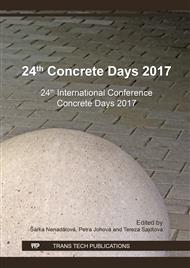p.185
p.189
p.197
p.203
p.209
p.214
p.220
p.226
p.232
UHPC Reinforced by Hybrid Fibers and its Resistance to High Temperature Loading
Abstract:
As part of the development and research of UHPC materials, the broad professional public deals mainly with the determination of the basic physical and mechanical parameters, in particular the compressive strength, that is considered as a determining parameter for these cement-based composites. The strength of the composite material is determined under normal laboratory conditions. Fine cement-based composite materials are increasingly used not only for academic purposes but also for practical applications. Therefore, it is necessary to focus on other parameters that determine these new Hi-Tech materials. The mechanical properties of materials at elevated temperatures belong to an area that is not properly defined not only in the Czech Republic but also in the world. Research into the behavior of these composite materials and their thermal loading can provide additional information and basics to expand these building materials such as France, USA, Japan and other countries around the world. In the Czech standards applicable to the design of concrete structures subjected to thermal stress, the values of the reduction coefficient Kc, θ are used only for commonly used dense concrete and also for expanded concrete. It is clear that these values cannot be used for fine-grained composite materials with cement binder reinforced hybrid reinforcements. The aim of the paper is to determine and describe the behavior of these materials in the temperature range of 20 ° C to 1000 ° C for two test modes that affect residual strength and high temperature strength.
Info:
Periodical:
Pages:
209-213
Citation:
Online since:
February 2018
Authors:
Keywords:
Price:
Сopyright:
© 2018 Trans Tech Publications Ltd. All Rights Reserved
Share:
Citation:


